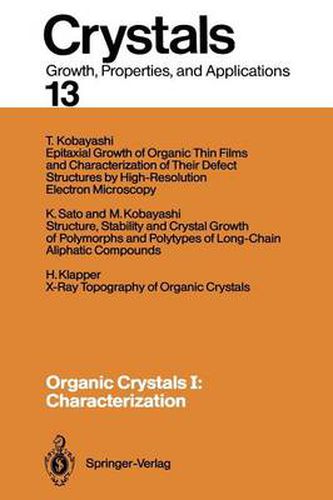Readings Newsletter
Become a Readings Member to make your shopping experience even easier.
Sign in or sign up for free!
You’re not far away from qualifying for FREE standard shipping within Australia
You’ve qualified for FREE standard shipping within Australia
The cart is loading…






This title is printed to order. This book may have been self-published. If so, we cannot guarantee the quality of the content. In the main most books will have gone through the editing process however some may not. We therefore suggest that you be aware of this before ordering this book. If in doubt check either the author or publisher’s details as we are unable to accept any returns unless they are faulty. Please contact us if you have any questions.
Lattice defects of organic molecular crystals affect their optical or electrical properties by changing the local energy structure. Lattice defects also playa very important role in the chemical and physical properties, for example, as an active site of a catalyst or an initiating point of a solid state reaction. However, very little has been reported on the defect structure of real organic crystals. In the past ten years it became clear that the origin and the structure of the defects depend on the geometrical and chemical nature of the building units of the crystal, the molecules. Molecular size, form and anisotropy, charge distribution, etc. cause the characteristic structure of the defect. Accordingly, a defect structure found in one compound may not be found in others. The defect structure of an organic crystal cannot be defined solely by the displacement of the molecular center from the normal lattice site. A rotational displacement of a molecule is frequently accompanied by a parallel shift of the molecular center. In addition to the usual geometrical crystallographic defects, chemical defects are important too which originate, for example, from differences in the substitution sites of molecules carrying side groups. In order to reveal such defect structures, direct imaging of molecules by high resolution electron microscopy is the only direct method.
$9.00 standard shipping within Australia
FREE standard shipping within Australia for orders over $100.00
Express & International shipping calculated at checkout
This title is printed to order. This book may have been self-published. If so, we cannot guarantee the quality of the content. In the main most books will have gone through the editing process however some may not. We therefore suggest that you be aware of this before ordering this book. If in doubt check either the author or publisher’s details as we are unable to accept any returns unless they are faulty. Please contact us if you have any questions.
Lattice defects of organic molecular crystals affect their optical or electrical properties by changing the local energy structure. Lattice defects also playa very important role in the chemical and physical properties, for example, as an active site of a catalyst or an initiating point of a solid state reaction. However, very little has been reported on the defect structure of real organic crystals. In the past ten years it became clear that the origin and the structure of the defects depend on the geometrical and chemical nature of the building units of the crystal, the molecules. Molecular size, form and anisotropy, charge distribution, etc. cause the characteristic structure of the defect. Accordingly, a defect structure found in one compound may not be found in others. The defect structure of an organic crystal cannot be defined solely by the displacement of the molecular center from the normal lattice site. A rotational displacement of a molecule is frequently accompanied by a parallel shift of the molecular center. In addition to the usual geometrical crystallographic defects, chemical defects are important too which originate, for example, from differences in the substitution sites of molecules carrying side groups. In order to reveal such defect structures, direct imaging of molecules by high resolution electron microscopy is the only direct method.